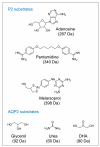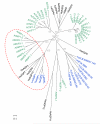Drug resistance in African trypanosomiasis: the melarsoprol and pentamidine story
- PMID: 23375541
- PMCID: PMC3831158
- DOI: 10.1016/j.pt.2012.12.005
Drug resistance in African trypanosomiasis: the melarsoprol and pentamidine story
Abstract
Melarsoprol and pentamidine represent the two main classes of drugs, the arsenicals and diamidines, historically used to treat the diseases caused by African trypanosomes: sleeping sickness in humans and Nagana in livestock. Cross-resistance to these drugs was first observed over 60 years ago and remains the only example of cross-resistance among sleeping sickness therapies. A Trypanosoma brucei adenosine transporter is well known for its role in the uptake of both drugs. More recently, aquaglyceroporin 2 (AQP2) loss of function was linked to melarsoprol-pentamidine cross-resistance. AQP2, a channel that appears to facilitate drug accumulation, may also be linked to clinical cases of resistance. Here, we review these findings and consider some new questions as well as future prospects for tackling the devastating diseases caused by these parasites.
Copyright © 2013 Elsevier Ltd. All rights reserved.
Figures




References
-
- Ehrlich P. Chemotherapeutische Trypanosomen-Studien. Berliner klinische Wochenschrift. 1907;9:233–236.
-
- Wastling SL, Welburn SC. Diagnosis of human sleeping sickness: sense and sensitivity. Trends Parasitol. 2011;27:394–402. - PubMed
-
- Priotto G, et al. Nifurtimox-eflornithine combination therapy for second-stage African Trypanosoma brucei gambiense trypanosomiasis: a multicentre, randomised, phase III, non-inferiority trial. Lancet. 2009;374:56–64. - PubMed
-
- Simarro PP, et al. Update on field use of the available drugs for the chemotherapy of human African trypanosomiasis. Parasitology. 2012;139:842–846. - PubMed
Publication types
MeSH terms
Substances
Grants and funding
LinkOut - more resources
Full Text Sources
Other Literature Sources

